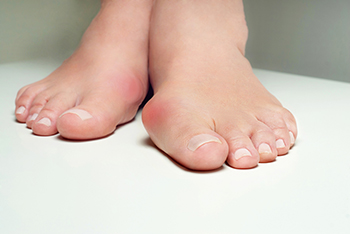
Bunions are all too common and affect all ages of people. They are more apt to happen to women, thought to be because of the pointy-toed, or high-heeled fashionable shoes they wear. However, they are not only caused by shoes, as bunions can happen to people in cultures who do not wear shoes. A bunion is a bony deformity of the big toe joint, also known as hallux valgus. When one has a bunion, their foot appears wider, and shoes can press on the painfully deformed joint. Pressure from the shoes pushes the big toe towards the second toe and the first joint bulges on the side of the foot. As the condition progresses, the second toe may lie over the top of the big toe, which leads to further pressure and distortion of footwear. Hard skin and corns may develop on the bunion and top of the second toe because they rub on shoes. This makes walking difficult, too. Bunions are easy to see. They are red, hot, painful, and swollen. A fluid-filled sac called a bursa sometimes develops over the joint to try and protect it from damage. Due to degenerative changes, arthritis might develop as well. If you suffer from a bunion, make sure to wear shoes that have enough room for the toes to move freely, with the bunion, and see a podiatrist for other suggestions and treatment options.
If you are suffering from bunion pain, contact Dr. Kennedy Legel of Advanced Foot & Ankle Care Specialists. Our doctor can provide the care you need to keep you pain-free and on your feet.
What Is a Bunion?
Bunions are painful bony bumps that usually develop on the inside of the foot at the joint of the big toe. As the deformity increases over time, it may become painful to walk and wear shoes. Women are more likely to exacerbate existing bunions since they often wear tight, narrow shoes that shift their toes together. Bunion pain can be relieved by wearing wider shoes with enough room for the toes.
Causes
- Genetics – some people inherit feet that are more prone to bunion development
- Inflammatory Conditions – rheumatoid arthritis and polio may cause bunion development
Symptoms
- Redness and inflammation
- Pain and tenderness
- Callus or corns on the bump
- Restricted motion in the big toe
In order to diagnose your bunion, your podiatrist may ask about your medical history, symptoms, and general health. Your doctor might also order an x-ray to take a closer look at your feet. Nonsurgical treatment options include orthotics, padding, icing, changes in footwear, and medication. If nonsurgical treatments don’t alleviate your bunion pain, surgery may be necessary.
If you have any questions, please feel free to contact our office located in Dallas, TX . We offer the newest diagnostic and treatment technologies for all your foot care needs.






















